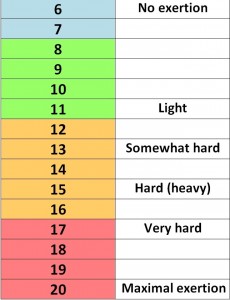 When working out most of us would like to know if we are doing too much, or not enough. Or… you might not. But you should. Workout intensity is something that can increase or decrease with minor changes, but can cause you to not see the outcomes you want or expect if not high enough, or can cause serious injury if it is too high. If you are not pushing your body beyond its normal activity level your body will not need to change anything. So if you have been taking that same 30 minute walk around the park for the past five years hoping to lose weight, it is not likely going to happen. Your body is great at adapting to the stresses you place on it. If a walk in the park is not a stress, it will not change. On the other side, if you are stressing your body too much you could suffer from overtraining syndrome and your body could begin to fail. So how do we measure exercise intensity? There are several methods, some complex, some easy, but not one that is the magical method and proven to be the end-all for measuring exercise intensity. Below are the two most common methods.
When working out most of us would like to know if we are doing too much, or not enough. Or… you might not. But you should. Workout intensity is something that can increase or decrease with minor changes, but can cause you to not see the outcomes you want or expect if not high enough, or can cause serious injury if it is too high. If you are not pushing your body beyond its normal activity level your body will not need to change anything. So if you have been taking that same 30 minute walk around the park for the past five years hoping to lose weight, it is not likely going to happen. Your body is great at adapting to the stresses you place on it. If a walk in the park is not a stress, it will not change. On the other side, if you are stressing your body too much you could suffer from overtraining syndrome and your body could begin to fail. So how do we measure exercise intensity? There are several methods, some complex, some easy, but not one that is the magical method and proven to be the end-all for measuring exercise intensity. Below are the two most common methods.

1. Borg Scale of Perceived Exertion (see picture to the right) – This is a simple tool that takes into account your fitness level. It uses a scale from 6-20 with a score of 6 being no exertion as when watching TV or reading a book, and a 20 indicating that the activity is so hard you cannot maintain it at that level for long. Dr Borg also built the scale to correspond with your heart rate: multiply the number on the scale by 10 to estimate your heart rate. So if your heart rate is 170 you are at a very hard intensity workout level.
2. Heart Rate – The higher your heart rate, the higher the workout intensity. Sure, that seems obvious, but you need to be able to quantify this to know how intense your workout is. Measuring your heart rate maximum, or heart rate max, is the most common way to objectively test your exercise intensity. The most widely used formula to calculate your heart rate max is 220-age. So if you are 50 years old, your heart rate max would be 170 beats per minute, or bpm. Now this number is NOT your goal when working out. But it helps to determine what is a good workout intensity for you. Typically you would want to work out between 45% and 85% of your heart rate max depending on the goals you want to achieve.
Ultimately you need to listen to your body and understand that even these formulas or scales have their flaws. Warning, these formulas do not take into account any known or unknown health issues! You should consult with your doctor before working out at a hard, or very hard intensity level on the Borg Scale or above 60% of your heart rate maximum. And for those in great shape you need to be aware that a well trained elite athlete may not be able to reach his or her heart rate max due to the efficiency of their trained hearts. You also need to assess your goals for working out and at what exercise intensity your goals are best achieved. For instance, a high intensity workout at 85% of your heart rate max, or a 18-20 on the Borg Scale, will not achieve your weight loss goals. So it is best to speak with a medical or healthcare professional about your goals to establish the intensity that will put you on the best path to achieve them.
